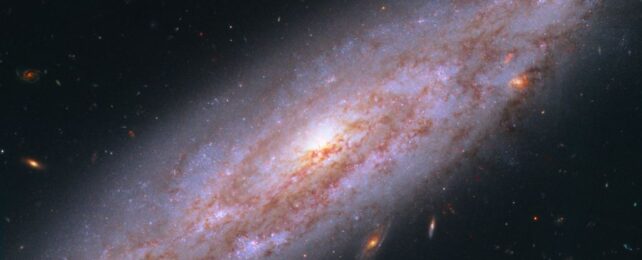A persistent, nagging problem with the expansion speed of the Universe may not require a rewrite of everything we know about physics.
New measurements taken using the James Webb Space Telescope suggest that the local Universe is zooming away from us at a rate of around 70 kilometers (about 43 miles) per second per megaparsec.
This is huge if true. It could finally resolve a discrepancy between measurements of the accelerating expansion of the Universe that has deviled scientists for the better part of a century: the Hubble tension, sometimes called the biggest crisis in cosmology.
We're going to need a lot more work before we can declare the problem definitively resolved, but the new measurements – made using three different kinds of star – could be a significant step forward. The findings have been submitted to The Astrophysical Journal and are available on arXiv.
"Based on these new JWST data and using three independent methods, we do not find strong evidence for a Hubble tension," says astronomer Wendy Freedman of the University of Chicago. "To the contrary, it looks like our standard cosmological model for explaining the evolution of the Universe is holding up."
Here's the deal. The Universe is expanding at an accelerating rate known as the Hubble constant. To calculate this constant, we can use different kinds of observables, which all give their own measures.
Observables from the early Universe include the cosmic microwave background – that's the leftover microwave radiation from the first light that streamed through the Universe – and baryon acoustic oscillations, which are patterns in the spread of distant galaxies consistent with waves that once rippled through the early Universe.
These two signals are known as standard rulers, because we know how big they are. They allow us to directly obtain accurate distance measurements, and suggest that the Universe is expanding at an accelerating rate of around 67.4 kilometers per second per megaparsec.
Signals from the nearby Universe are known as standard candles. These are objects of known intrinsic brightness, such as Cepheid variable stars and Type Ia supernovae. Because we know how bright they are, we can accurately calculate their distance, too. And they suggest a Hubble constant of around 74 kilometers per second per megaparsec.
Now, both types of measurement have error bars that overlap with each other, so this discrepancy isn't the end of cosmology as we know it. But it would be really nice to land confidently on a more precise figure for one expansion rate. Or, if there are multiple expansion rates, an explanation for why different parts of the Universe expand differently.
Freedman has been working for some years on measuring the Hubble constant using different methods from the more traditional standard candles. In particular, she has been focusing on stars at the tip of the red giant branch, or TRGB stars.
These stars reach a uniform size and brightness, making them an accurate tool for measuring the distance to nearby galaxies. Using observations from various instruments, such as Hubble and Gaia, Freedman and her colleagues made several TRGB measurements that returned a Hubble constant of around 69 to 70 kilometers per second per megaparsec.
Enter the James Webb Space Telescope, which is the most powerful space telescope ever deployed. Now, Freedman and her team have used it to also measure TRGB stars, as well as Cepheid variable stars, and a type of carbon-rich giant star that, they say, is a new type of standard candle based on their stable brightness.
By measuring distances to all three stars independently, the researchers obtained a wealth of data that they could use to cross check for systematic errors to obtain an independent measurement of the Hubble constant.
For the TRGB stars, the researchers obtained a value of 69.85 kilometers per second per megaparsec. For the carbon stars, they got 67.96. The Cepheid variables were a little bit of an outlier, at 72.05, but the error bars for all three overlap.
"Getting good agreement from three completely different types of stars, to us, is a strong indicator that we're on the right track," Freedman says.
We're not out of the woods yet. Although the measurement falls within the error bars of both standard rulers and standard candles, we've been deriving different values for far too long for the issue to be resolved so abruptly. In fact, just earlier this year a JWST measurement of Cepheid variable stars and Type Ia supernovae was used to confirm Hubble's measurement of 73 kilometers per second per megaparsec.
So, we're going to need a lot more measuring, and re-measuring, and measuring again. Just to be sure. Yet the new numbers suggest variables between different observables still might actually account for the discrepancy, without needing to introduce any major new theories.
Still, who knows? Maybe we'll even stumble across some new physics in the search for an answer after all.
The research has been submitted to The Astrophysical Journal, and is available on arXiv.
